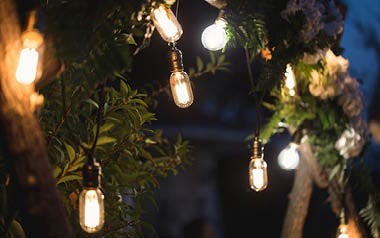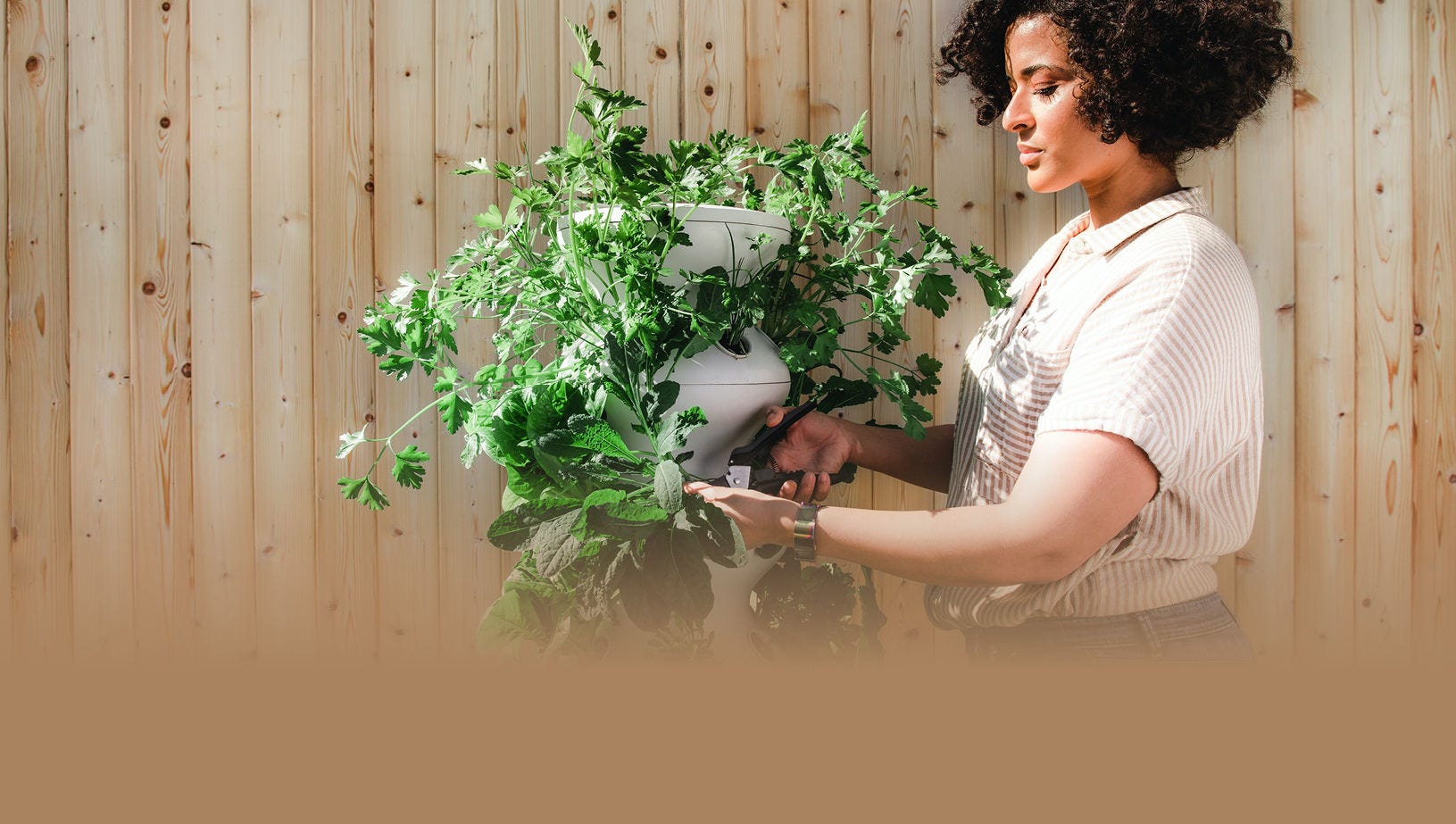As the importance of eco gardening continues to be recognised, our interest in the plants and flowers that help us achieve that life follows suit. The idea of adopting a fully sustainable lifestyle (or permaculture) is one that's fast growing. Many of us are taking the time to transform our outdoor living areas into inviting spaces enriched with beautiful blooms.
From luscious green lawns to succulent shrubs and hedges filled with fabulous florals, our focus on home improvements has shifted from the snug sanctuary within the walls of our homes, to the outdoor living areas we’re eager to enjoy throughout the year, but especially during those warmer months.
But how can we make the most of our gardens in the most eco-friendly way possible? With artificial substitutes lessening in popularity (great news for the planet!), it’s worth taking the time to consider the ways in which we can truly maximise the self-sufficient appeal of our gardens. So, whether you’re a novice gardener looking for ways to beautify your outdoor space, or you’re an expert who’s simply hoping to pick up some eco-friendly gardening tips, you’ve come to the right place.


1. Explore the ‘No Dig’ method
An attractive way of growing, the ‘no dig’ method helps encourage the development of a natural, nutrient-rich soil in which plants and flowers can truly thrive. Also a highly effective means of clearing weed-infested areas, this method is simple - avoid digging in order to prevent disrupting the soil life. Soil life is enriched with fungi, worms and microorganisms that work alongside one another to help feed the plant roots, encouraging growth and health.
There are two methods of no dig gardening, the first is by clearing a new area to cultivate your bed or allotment:
- Slash your tall weeds, then shield them with a light blocking material like cardboard (don’t use carpet as the chemicals will likely kill your plants) so they can’t grow and eventually die away.
- Add a deep layer of organic matter (we recommend which types below), then tread it down firmly so it can rot.
- After six months to a year, the weeds below will have died and you can then plant whatever you like in the soil!
For an area that’s already cultivated and weedless, the method is much quicker!
- Apply a 15cm (6.5″) layer of organic matter to your area, then firm it down.
- Plant seeds directly in the soil as you would normally, and just use a trowel to take away any weeds that manage to poke through the soil.
- Every autumn or spring, add another 5cm (2″) layer of organic matter on top of the area to protect the root soil below.
Anyone can make use of this sustainable gardening method, providing they have access to a considerable quantity of organic matter. Homemade compost, well-rotted manure, green waste, peat-free compost and leaf mould can all be used.
2. Learn more about plant association
Plant association is the technique of selectively grouping plants that naturally complement one another, bringing harmony to your garden. A technique that’s also known as ‘companion planting’, this method is incredibly valuable when preventing pests and achieving optimal growth and health.
One of the easiest ways to group plants is by their aesthetic, but as tempting as it is to go for the look, there are better ways to group plants to let them thrive. Your plants will naturally benefit if you think about how they work side by side with each other.
In some cases, companion planting also promotes super-healthy growth without the need for artificial plant foods. Here are some reasons you should start trying it in your garden:
Better soil fertility - Some plants draw nitrogen out the air(which is known as nitrogen-fixing), which means they can help non nitrogen-fixing plants grow with them
Natural trellis - Tall growth plants act as a natural scaffolding for your climbers
Shade regulators - Some plants love the sun, and can act as a natural sun visor for the plants that need shade
Weed control - Wide ground-covering plants stop weeds from growing around and killing your delicate and upright thin plants
This method is ideal if you’re looking to protect more delicate plant species that may otherwise struggle to survive challenging environmental factors and threats, like the bugs that are desperate to eat your crop!
Physiognomy refers to grouping plants by their physical attributes, so, for example, organising clusters of grasses, bunching shrubs and clustering hardy perennials. When you do this, certain plants can gain from the properties of their pairings.
Did you know that some plants act as natural pesticides for each other? Some plant combinations act as the ideal deterrent to stop nasty pests from ruining a season’s worth of growth.


And if you’re looking for more natural ways to keep those pests at bay, keep reading…
3. Make use of chemical-free pest control
One of the few unfortunate aspects of keeping a natural garden that’s rich in plantation is, of course, pests. Keeping pests and bugs away from plants can prove a rather tricky task, but a necessary one if you wish to maintain premium plant health and prevent crops from being eaten.
Pesticides aren’t difficult to come across - in fact, the market is flooded with chemical pest control solutions that will almost certainly keep the nasties at bay. If you’re keen to steer clear of chemicals - a much safer and eco-friendly means of conducting pest control - it’s good to know that the world has intelligently developed its own, highly effective natural alternatives to pesticides through companion planting. Essential oils or Citronella candles can also be used to discourage flies and bees, meanwhile simple techniques like crop rotation help deter certain bugs as they won’t nest hoping to find the same plant year after year.
Some of the best natural pest control you can use is other plants and herbs. You already know about companion planting, but here are our favourite herbs to grow in your vegetable patch:
Basil - goes as well with your tomatoes in the outdoors as it does on your plate, make sure you grow it indoors away from frost until it’s ready to go into a well-shaded part of your garden
Mint - smells great, and keeps away white cabbage moths, aphids and ants. Mint tends to grow aggressively so you may rather plant it in pots to place around your garden!
Rosemary - an annual perennial that grows in most regions and climates. Its aroma keeps moths, slugs and snails away if it’s planted near leafy greens and anything in the cabbage family.
Lavender - This aromatic herb is part of the mint family, and thrives in sunny conditions. Plant lavender in your garden to keep moths, flies and mosquitoes from feasting on your vegetables.
If you don’t have the time to plant these herbs, why not create a homemade, chemical-free pest spray? Two of our favourite natural pesticides are sea salt spray or onion and garlic spray, and they’re super-easy to make in the kitchen!
Sea Salt Spray - Mix sea salt and water into a spray bottle and use it on your outdoor plants. This has the double benefit of keeping pests at bay, while promoting magnesium absorption which is a crucial nutrient for your greens!
Onion and Garlic Spray - Blend four cloves of garlic, one onion, two mugfulls of water and two spoons of a chilli powder like cayenne pepper together. This is your concentrated mix. Dilute a small batch of this (while freezing the rest) with water into a spray bottle with a dash of liquid soap to effectively keep the pests at bay.
4. Is dry gardening the way to go?


Plants each have their own individual set of ideal growing conditions, and while some plants flourish in wetter environments, others reach optimal health when exposed to large amounts of sun and drier conditions.
For areas of the world that don’t get as much rainfall, dry gardening techniques will help you store water in your soil. The plants you sow will reap the benefits of this, as long as you follow some basic rules:
- Choose crops that can grow in dry or arid conditions
- Make sure you plant less crops further apart so they don’t take up each other’s space
- Don’t let soil moisture evaporate during the driest seasons
Here are our top three tips for dry gardening (there are plenty more, which you can find here)
- Add organic matter like compost to your garden - Adding a top layer like this helps the soil below retain water throughout the dry months.
- No weeds, ever - Weeds will kill your plants because they grow quickly and compete with them for any water or nutrients in the soil.
- Windbreaks protect your crop - Stop the wind from getting to your plants in the summer as it’ll dry out your crop. Some plants like Jerusalem artichoke and sunflowers act as natural windbreaks.
Dry gardening is a particularly effective gardening method for those located in the EU, rather than the UK, with gardens built on sloped ground reaping maximum benefits. The excess water runoff will prove detrimental to plants that require more food, and planting shrubs and flowers that can be left alone will help conserve water in the long term.
Think about plants that thrive in the heat and still look good. Mediterranean plants like santolina, cistus, and phlomis grow well in those conditions. The main thing you should consider is that the drainage of any dry garden needs to be deep, and filled with materials like sand, gravel, crushed hardcore or recycled concrete.
5. Turn your attention to peat-free soil
Set to be banned in the UK by 2024, peat soil is being phased out, with peatless soil now beginning to take centre-stage. Peat-based compost products have been found to be damaging to the environment, as they are causing ozone-friendly peat bogs to disappear. So sourcing eco-friendly alternatives has become a point of interest to experienced and novice gardeners alike.
One of the best ways to improve the nutrient density of the soil in your eco-friendly garden is to use homemade compost. A time-consuming commitment - but one with many advantages - creating your own compost requires saving natural food waste and allowing it to rot before adding it to the garden to improve soil nutrition.
6. Encouraging wildlife into the garden
While slugs and certain bugs can be unwelcome visitors in the garden, not all wildlife is discouraged. In fact, inviting wildlife into the garden is actually great. The bigger animals naturally move nutrients around your space, their waste can act as compost for your plants, plus they’ll eat the bugs that see your vegetables as a snack.
Fashioning small entrances for hedgehogs to make their way into the garden and building bug hotels are just a couple of ways in which you can welcome wildlife into your garden in a positive way. This is known as rewilding, which you can read more about here.
It’s also a good idea to plant at various heights in order to encourage birds to graze in your garden, and to plant shrubs and flowers that are native to where you live. Exotic blooms can look incredibly beautiful, but native plants will attract native wildlife, which in turn, supports the ecosystem.
Another highly effective way to bring wildlife into your outdoor space is to partake in the UK’s famed ‘No Mow May.’ A campaign that encourages British gardeners to abandon their lawn mowers for an entire month, this simple method helps encourage bugs and animals to make use of the garden, keeping the wider environment thriving around you.
7. Add in a water feature


Even the most compact of water features can work wonders for the environment, so don’t be put off if your outdoor space is on the smaller side. As it is left to grow, your water feature will begin to flourish as an ecosystem of its own, encouraging wildlife and plants into a unique eco garden nestled right outside your back door.
For those small gardens, you could create tiny ponds in barrels or boxes using sand, water and greenery like pondweed to keep the ecosystem healthy. Read more about how to design a pond for a small space here.
8. Grow your own food
Growing food is yet another gardening trend that’s now more desirable than ever. Adopting a self-sufficient lifestyle by growing fruit and vegetables in the comfort of our own gardens is an incredibly appealing concept, and one that’s beneficial to both us (the ones eating the veggies) and the planet.
The term ‘plot to plate’ is one that’s on everybody’s lips right now, and basically refers to the concept of taking fruits and vegetables directly from the plot they were grown in, and onto the plate that we eat from. There are no middle men with this process, no mass production lines, no chemical pesticides - just a wholly organic and fulfilling way of enjoying your favourite fruits and veg. From sweet, crunchy apples to succulent marrows, juicy strawberries and flavourful herbs (plus the rest!), the possibilities are endless.
Of course, perfecting the crop is something that takes time and practice, so don’t be disheartened if your first batch isn’t your best. For more help and inspiration, be sure to check out our Guide to Summer Fruit and Veg for useful tips and tricks.
9. Try your hand at forest planting
Another method well worth exploring is forest planting. Also known as forest gardening, this unique process aims to mimic the natural cycle of the ecosystem of a large forest on a micro scale in a garden of any size. It’s worth bearing in mind that this is a long-term project and it can take years to develop this micro ecosystem. So if you’re renting your home or planning on moving soon, it might be worth waiting before implementing a forest garden in your home.
The aim of forest planting is to adopt complete self-sufficiency by creating seven ‘layers’ of plants, trees and shrubs in any one place. Initially, this involves a great deal of hard work, but the long-term benefits once the crops are established are well worth it.
Forest gardening was a concept that was first developed in the 1970s by British gardener Robert Hart. His research led him to design a miniature woodland by replicating the natural layers that plants occupy in forests on a much smaller scale.


The seven layers of forest planting are:
- A canopy layer of mature fruit trees
- A low-tree layer of smaller fruit trees
- A shrub layer of fruit bushes like berries
- A herbaceous layer of perennial vegetables and herbs
- A ground cover of plants that are edible and spread horizontally
- An underground layer of plants that are grown for their edible roots, this is also known as a ‘rhizosphere’
- A vertical layer of climbers and vines
To make sure a forest garden becomes self-sufficient over time, it’s best to plant a wide range of species to ensure diversity for your space. And once your layers are established, it takes little to no effort for you to reap the rewards of your crops!
Just bear in mind that this can be a more difficult technique of creating a sustainable garden, so make sure you do plenty of research before deciding to give forest planting a try!
There’s never been a better time to explore the world of planting. So, if you haven’t already, pull on your wellies, grab your gardening gloves and get set to immerse yourself in the joyful world of eco gardening.
For more garden, lifestyle and home inspiration, head over to our blog, read our sustainability commitment here, and see our latest seasonal collection of fragrances here.













